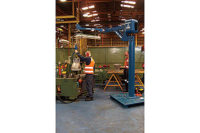Workplace ergonomics is important to AUMA Reister GmbH & Co. KG, an international manufacturer of electric valve actuators and valve gearboxes for 50 years. This is because its workers often need to handle large or heavy components of these products.
The company’s latest ergonomics challenge involved removing a 73-pound motor housing from its cardboard box and filling it with a 100-pound assembled motor. Initially, workers used a sling or strap to perform both tasks. Next, the company had workers use a swiveling jib crane that allowed one-hand operation.
Finally, the company worked with FIPA GmbH to develop a custom gripper to perform both tasks. Because the box is narrow, it provides very little room for maneuvering. This forced FIPA’s engineers to develop a pivoting gripper that quickly and easily mounted onto the housing.
The gripper features two pneumatically driven half shells held securely in place by springs—even if there’s a loss of compressed air. There are also four tappets that directly insert into the housing’s mounting holes. At the front of each tappet is a horizontal surface, on which the housing rests during handling.
The worker positions the gripper (hanging at the end of the crane) above the housing and presses a button on the gripper. Air pressure moves the gripper’s two half shells outward so the tappets are above the holes.
The worker aligns the tappets with the holes and lowers the gripper until it sits flat on the housing and the tappets enter the holes. He presses the button to move the gripper inward and grab the housing. Securely held, the housing is quickly lifted out of the box. This process is reversed to place an assembled motor into the box.
A spokesperson for AUMA says the main benefits of the gripper are fewer back injuries to workers and increased productivity. Equally important, the gripper offers a high degree of process reliability.
For more information on grippers, call 919-651-9888 or visit www.fipa.com.


